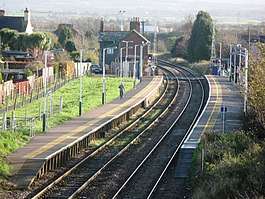Pinhoe railway station
Pinhoe railway station is on the eastern edge of the city of Exeter in Devon, England, that serves the village of Pinhoe. It was opened by the London and South Western Railway (LSWR) in 1871 but is now operated by South Western Railway which provides services on the West of England Main Line. It is 168 miles 44 chains (271.3 km) down the line from London Waterloo.
| Pinhoe | |
|---|---|
 | |
| Location | |
| Place | Pinhoe |
| Local authority | Exeter |
| Coordinates | 50.7377°N 3.4698°W |
| Grid reference | SX962941 |
| Operations | |
| Station code | PIN |
| Managed by | South Western Railway |
| Number of platforms | 2 |
| DfT category | F2 |
| Live arrivals/departures, station information and onward connections from National Rail Enquiries | |
| Annual rail passenger usage* | |
| 2014/15 | |
| 2015/16 | |
| 2016/17 | |
| 2017/18 | |
| 2018/19 | |
| History | |
| Original company | London and South Western Railway |
| Post-grouping | Southern Railway |
| 1871 | Opened |
| 1966 | Closed |
| 1983 | Reopened |
| National Rail – UK railway stations | |
| * Annual estimated passenger usage based on sales of tickets in stated financial year(s) which end or originate at Pinhoe from Office of Rail and Road statistics. Methodology may vary year on year. | |
History
The LSWR opened its Exeter Extension from Yeovil Junction to Exeter Queen Street on 19 July 1860 but no station was provided at Pinhoe at that time. The village's station opened eleven years later on 30 October 1871. The original wooden footbridge was replaced by a concrete structure cast at nearby Exmouth Junction works, the first such footbridge erected by the Southern Railway, which had taken over from the LSWR in 1923.[1]
Goods facilities were provided from 3 April 1882, and in 1943 a government food cold store was built to the west of the station that was served by its own siding. The passenger station was closed by on 7 March 1966 when the Western Region of British Railways withdrew the local stopping services from the line. Goods facilities were withdrawn on 10 June 1967 and the cold store siding (now operated by a private company) closed in 1979.[2]
The station was reopened by British Rail on 16 May 1983. Instead of a country village it was now on the eastern edge of the city. The initial trial period for commuter services proved successful[1] and a regular service now operates all day, seven days a week.[3] Between 2003 and 2008 passenger numbers increased by 530% and they are still increasing with an estimate of 94,354 users in 2015-16.[4]
| Preceding station | Historical railways | Following station | ||
|---|---|---|---|---|
| Broad Clyst | London and South Western Railway Salisbury to Exeter |
Whipton Bridge Halt | ||
Signalling
The station was built next to the level crossing of Pinn Lane. This was operated by the station staff until 1875 when a small signal box was brought into use; it was situated on the north side of the line to the east of the road. The initial 11 levers were extended to 17 in 1943 when the cold store was built. On 11 June 1967 one of the two tracks between Pinhoe and Honiton was taken out of use and trains towards London would often wait in the closed station for a westbound train to clear the 14-mile (23 km) single track section. The level crossing gates were replaced with lifting barriers on 17 March 1968. The signal box was finally closed on 13 February 1988, the level crossing and signals now being controlled from Exmouth Junction.[2] The old signal box was dismantled and re-erected in the railway museum at Bere Ferrers on the Tamar Valley Line.[1]
Description
The station is just south of the village centre to the west of Station Road and access to the platforms is from this road; a footpath also links the eastbound platform with Main Road.[5] A two-storey brick building between the road and the eastbound platform is the former station master's house. The main station building used to be next to this but was demolished after the station closed in the 1960s. Passengers waiting at the reopened station have to make do with glass and metal shelters.[1]
Services

Exeter railway stations | |||||||||||||||||||||||||||||||||||||||||||||||||||||||||||||||||||||||||||||||||||||||||||||||||||||||||
|---|---|---|---|---|---|---|---|---|---|---|---|---|---|---|---|---|---|---|---|---|---|---|---|---|---|---|---|---|---|---|---|---|---|---|---|---|---|---|---|---|---|---|---|---|---|---|---|---|---|---|---|---|---|---|---|---|---|---|---|---|---|---|---|---|---|---|---|---|---|---|---|---|---|---|---|---|---|---|---|---|---|---|---|---|---|---|---|---|---|---|---|---|---|---|---|---|---|---|---|---|---|---|---|---|---|
| |||||||||||||||||||||||||||||||||||||||||||||||||||||||||||||||||||||||||||||||||||||||||||||||||||||||||
South Western Railway operate an hourly service (more frequently in the morning & evening) each way between London Waterloo and Exeter St Davids via Yeovil Junction and Salisbury.[6]
| Preceding station | Following station | |||
|---|---|---|---|---|
| Cranbrook | South Western Railway West of England Main Line |
Exeter Central | ||
References
| Wikimedia Commons has media related to Pinhoe railway station. |
- Oakley, Mike (2007). Devon Railway Stations. Wimbourne: The Dovecote Press. ISBN 978-1-904349-55-6.
- Phillips, Derek; Pryer, George (1997). The Salisbury to Exeter Line. Sparkford: Oxford Publishing Company. ISBN 0-86093-525-6.
- "Table 160: London to Salisbury and Exeter" (PDF). Electronic National Rail Timetable. Network Rail. December 2009. Retrieved 14 December 2009.
- "Station Usage". Rail Statistics. Office of Rail Regulation. Archived from the original on 10 July 2014. Retrieved 16 December 2016.
- A–Z Exeter (4th ed.). Sevenoaks: Geographers’A–Z Map Company. 2007. p. 12. ISBN 978-1-84348-504-9.
- Table 160 National Rail timetable, May 2016